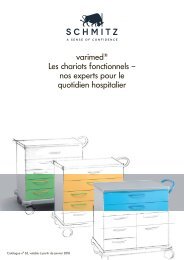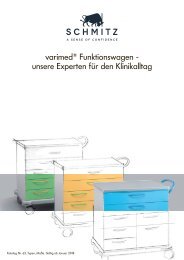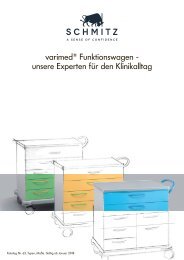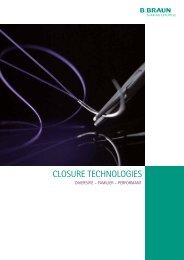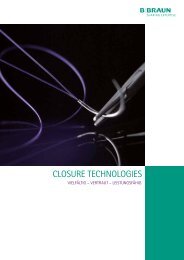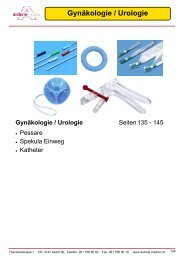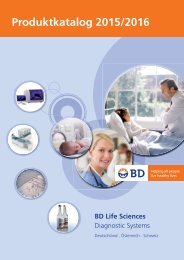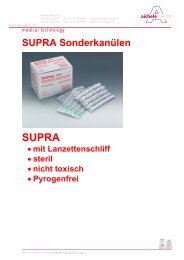BD Diagnostics EN
Create successful ePaper yourself
Turn your PDF publications into a flip-book with our unique Google optimized e-Paper software.
443419 24 tests <strong>BD</strong> MAX Staph SR - IVD Assay<br />
The <strong>BD</strong> MAX StaphSR Assay performed on the <strong>BD</strong> MAX System is an<br />
automated qualitative in vitro diagnostic test for the rapid detection of<br />
Staphylococcus aureus (SA) DNA and methicillin-resistant Staphylococcus<br />
aureus (MRSA) DNA from nasal swabs in patients at risk for nasal<br />
colonization. The test utilizes real-time polymerase chain reaction (PCR)<br />
for the amplification of specific DNA targets and fluorogenic targetspecific<br />
hybridization probes to detect and differentiate MRSA and SA<br />
DNA: specific amplicon in the SCCmec right-extremity junction (MREJ), the<br />
genes for methicillin resistance mecA and mecC, the gene nuc encoding<br />
a thermostable nuclease of S. aureus. The <strong>BD</strong> MAX StaphSR Assay is<br />
intended to aid in the prevention and control of MRSA and SA in site<br />
surgical infections (SSIs).<br />
443461 24 tests <strong>BD</strong> MAX MRSA XT - IVD Assay<br />
The <strong>BD</strong> MAX MRSA XT assay performed on the <strong>BD</strong> MAX System is<br />
an automated qualitative in vitro diagnostic test for the direct detection<br />
of methicillin-resistant Staphylococcus aureus (MRSA) DNA from nasal<br />
swabs in patients at risk for nasal colonization. The test utilizes real-time<br />
polymerase chain reaction (PCR) for the amplification of MRSA DNA and<br />
fluorogenic target-specific hybridization probes for the detection of the<br />
amplified DNA: specific amplicon in the SCCmec right-extremity junction<br />
(MREJ), the genes for methicillin resistance mecA and mecC, the gene nuc<br />
encoding a thermostable nuclease of S. aureus. The <strong>BD</strong> MAX MRSA XT<br />
assay is intended to aid in the prevention and control of MRSA infections in<br />
healthcare settings.<br />
443379 24 tests <strong>BD</strong> MAX CRE - RUO Assay<br />
The <strong>BD</strong> MAX CRE Assay is a research use only (RUO) assay designed to<br />
detect three antimicrobial resistance genes (KPC, OXA-48 and/or NDM)<br />
found predominantly in carbapenem-resistant Enterobacteriaceae (CRE).<br />
442963 24 tests <strong>BD</strong> MAX Enteric Bacterial Panel - IVD Assay<br />
The <strong>BD</strong> MAX Enteric Bacterial Panel, as implemented on the <strong>BD</strong> MAX <br />
System, is an automated in vitro diagnostic test for the direct qualitative<br />
detection of enteric bacterial pathogens. Enteric bacterial targets include<br />
Salmonella spp., Campylobacter spp. (jejuni and coli), Shigellosis disease<br />
causing agents [Shigella spp. and Enteroinvasive E. coli (EIEC)] as well<br />
as Shiga-toxin producing E. coli from unpreserved soft to diarrheal stool<br />
specimen or Cary-Blair preserved stool specimens from symptomatic<br />
patients with suspected acute gastroenteritis, enteritis or colitis. The test is<br />
performed directly on the specimen, utilizing real-time polymerase chain<br />
reaction (RT-PCR) for the amplification of SpaO, a Campylobacter specific tuf<br />
gene sequence, ipaH, stx 1a and stx 2a. The test utilizes fluorogenic genespecific<br />
hybridization probes for detection of the amplified DNA.<br />
442960 24 tests <strong>BD</strong> MAX Enteric Parasite Panel - IVD Assay<br />
The <strong>BD</strong> MAX Enteric Parasite Panel, as implemented on the <strong>BD</strong> MAX <br />
System, is an automated in vitro diagnostic test for the direct qualitative<br />
detection of enteric parasitic pathogens. Enteric parasite targets include<br />
Giardia lamblia, Cryptosporidium (C. hominis and C. parvum), and<br />
Entamoeba histolytica from unpreserved or formalin-fixed stool specimens<br />
from symptomatic patients with suspected gastroenteritis and/or colitis.<br />
The assay is intended to aid in the diagnosis of gastrointestinal infection<br />
when used in conjunction with clinical evaluation and other laboratory<br />
findings. The test is performed directly on the specimen, utilizing real-time<br />
polymerase chain reaction (qPCR) for the amplification of specific targets.<br />
The test utilizes fluorogenic gene-specific hybridization probes for detection<br />
of the amplified DNA.<br />
441772 24 tests <strong>BD</strong> MAX GBS - IVD Assay<br />
The <strong>BD</strong> MAX GBS Assay as implemented on the <strong>BD</strong> MAX System is a<br />
qualitative in vitro diagnostic test designed to detect Group B Streptococcus<br />
(GBS) DNA in Lim Broth cultures, after incubation for greater than or equal<br />
to 18 hours, obtained from vaginal-rectal swab specimens from antepartum<br />
pregnant women. The test incorporates automated DNA extraction to<br />
isolate the target nucleic acid from the specimen and real-time polymerase<br />
chain reaction (PCR) to detect a 124 bp region of the cfb gene sequence<br />
of the Streptococcus agalactiae chromosome. Results from the <strong>BD</strong> MAX<br />
GBS Assay can be used as an aid in determining colonization status in<br />
antepartum women.<br />
159




